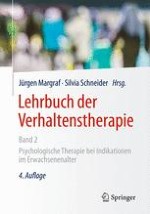Zusammenfassung
Die posttraumatische Belastungsstörung (PTBS) ist durch das Persistieren traumabezogener Symptome in einer Vielzahl von Erlebensbereichen im Nachgang eines traumatischen Ereignisses gekennzeichnet. Potenziell traumatische Ereignisse sind dabei definiert über das Vorliegen einer unmittelbaren Bedrohung des eigenen Lebens oder der körperlichen Integrität. Der Anteil von Betroffenen, die in Folge eines solchen Ereignisses das Vollbild einer PTBS entwickeln, ist mit ca. 15–24% erheblich, sodass diese im klinischen Alltag von hoher Relevanz ist. Geringe Spontanremissionsraten (ca. 30%) und häufig chronische Verläufe verweisen zudem auf die Notwendigkeit einer umfassenden und effektiven Behandlung. Dieses Kapitel gibt einen Überblick über die Symptomatik der PTBS, über kritische Entstehungsfaktoren und etablierte Behandlungsverfahren. Darüber hinaus wird auf aktuelle Erkenntnisse der Forschung bezüglich zugrundeliegender Prozesse und hinsichtlich neuer Therapieansätze hingewiesen.











